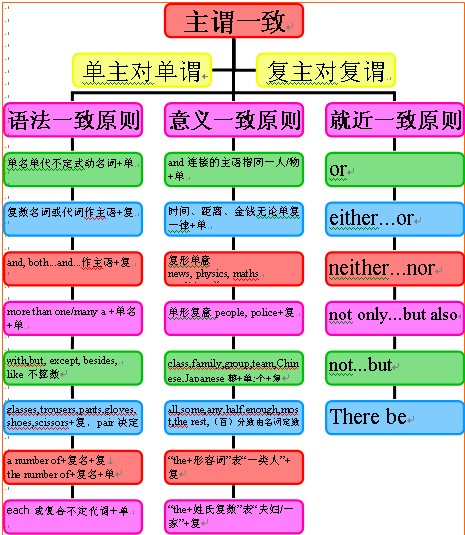本试题 “_____ of the city _____ two small lakes.A. The east; lieB. The east; liesC. East; lieD. East; lies” 主要考查您对全部倒装
主谓一致
等考点的理解。关于这些考点您可以点击下面的选项卡查看详细档案。
- 全部倒装
- 主谓一致
全部倒装的概念:
倒装英语句子的主语通常位于谓语动词之前,这种语序被称为正常语序。但有时出于修辞或某种特殊的语法结构的需要,需要将谓语动词放在主语之前,这种语序则叫倒装语序。主语和谓语完全倒置叫完全倒装。
完全倒装完全倒装的基本形式是“谓语+主语”,主要见于以下情况:
1、here和there位于句首时的倒装:
表示地点的here和there位于句首时,其后用完全倒装形式。这类倒装句的谓语通常是动词be和come,go等表示移动或动态的不及物动词:
如:Here's Tom. 汤姆在这里。
There's Jim. 吉姆在那儿。
Here comes the bus. 公共汽车来了。
There goes the bell. 铃响了。
There goes the last train. 最后一班火车开走了。
注:(1)以上倒装句中的谓语动词come和go不能用进行时态,即不能说:Here is coming the bus.
(2)若主语为代词,则不倒装:
如:Here I am. 我在这儿。/ 我来了。
Here it comes.它来了。
(3)其中的动词有时也可能是stand, lie, live等表示状态的动词(表示存在):
如:There stood a desk against the wall. 靠墙放着一张书桌。
Once upon a time there lived a man known by the name of Beef. 从前有个人名叫比夫。
2、away和down等位于句首时的倒装:
地点副词away, down, in, off, out, over, round, up等位于句首时,其后用完全倒装语序。这类倒装句的谓语通常表示动态的不及物动词:
如:Away went the runners. 赛跑选手们跑远了。
Round and round flew the plane. 飞机盘旋着。
The door opened and in came Mr Smith. 门开了,史密斯先生进了来。
Down came the rain and up went the umbrellas. 下雨了,伞都撑起来了。
注:若主语为人称代词,则不能用倒装:
如:Away he went. 他跑远了。
Down it came. 它掉了下来。
3、某些状语或表语位于句首时的倒装:
为了保持句子平衡或使上下文衔接紧密,有时可将状语或表语置于句首,句中主语和谓语完全倒装:
如:Among these people was his friend Jim. 他的朋友吉姆就在这些人当中。
By the window sat a young man with a magazine in his hand. 窗户边坐着一个年轻人,手里拿着一本杂志。
注:在表语置于句首的这类倒装结构中,要注意其中的谓语应与其后的主语保持一致,而不是与位于句首的表语保持一致。
比较:In the box was a cat. 箱子里是一只猫。
In the box were some cats. 箱子里是一些猫。
4、现在分词、过去分词或不定式置于句首的倒装:
有时为了强调,可将谓语部分的现在分词、过去分词或不定式置于句首,从而构成倒装:
如:Buried in the sands was an ancient village. 一个古老的村庄被埋在这沙土之中。
Standing beside the table was his wife. 站在桌旁的是他的妻子。
To be carefully considered are the following questions. 下列问题要仔细考虑。
主谓一致的概念:
谓语的数必须和主语的人称和数保持一致,这就叫主谓一致。
主谓一致的基本原则:
1)语法一致原则,即在语法形式上取得一致。例如,主语是单数形式,谓语动词也采取单数形式;主语是复数形式,谓语动词也采取复数形式。
例如:The students are very young.
This picture looks beautiful.
2)意义一致原则,即从意义着眼处理一致关系。例如,主语形式虽是单数但意义是复数,谓语动词也采取复数形式;
而有些主语形式虽是复数但意义上看作单数,谓语动词也采取单数形式。
例如:The people in that country are fighting for independence.
The crowd deeply respect their leader.
Three years in a strange land seems a long time.
3)就近原则,即谓语动词的单数或复数形式取决于最靠近它的词语。
例如:Neither hen or I am going to see the film tonight because we are busy.
几对容易混淆词组的一致用法:
1、由“this/thatkind/typeof+名词”作主语,谓语动词用单数形式;而由"these/thosekind/typeof+复数名词”作主语,谓语动词用复数形式。
例如:This kind of apples is highly priced.
Those kind(s) of tests are good.
2、由“a number of,a totalo f,an average of+复数名词”作主语,谓语动词用复数形式;由“the number of,the total of,the average of+复数名词”作主语,谓语动词用单数形式。
例如:A number of students are waiting for the bus.
The number of the students in this university is increasing yearly.
3、one of,the(only) one of的一致用法
例如:This is one of the books that have been recommended.
This is the(only) one of the books that has been recommended.
主谓一致用法点拨:
1、并列结构作主语谓语用复数:
如:Reading and writing are very important.
注意:当主语由and连结时,如果它表示一个单一的概念,即指同一人或同一物时,谓语动词用单数,and此时连接的两个词前只有一个冠词。
如:The iron and steel industry is very important to our life.
典型例题:
The League secretary and monitor___asked to make a speech at the meeting.
A. is
B. was
C. are
D. were
答案:B.
注:先从时态上考虑。这是过去发生的事情应用过去时,先排除A、C本题易误选D,因为The League secretary and monitor 好象是两个人,但仔细辨别,monitor前没有the,在英语中,当一人兼数职时只在第一个职务前加定冠词。后面的职务用and相连。这样本题主语为一个人,所以应选B。
2、主谓一致中的靠近原则:
1)当there be句型的主语是一系列事物时,谓语应与最邻近的主语保持一致。
例如:There is a pen, a knife and several books on the desk.
There are twenty boy-students and twenty-three girl-students in the class.
2)当either…or…与neither…nor,连接两个主语时,谓语动词与最邻近的主语保持一致。
如果句子是由here, there引导,而主语又不止一个时,谓语通常也和最邻近的主语一致。
例如:Either you or she is to go.
Here is a pen, a few envelops and some paper for you.
3、谓语动词与前面的主语一致:
当主语后面跟有with, together with, like, except, but, no less than, as well as等词引起的短语时,谓语动词与前面的主语一致。
例如:The teacher together with some students is visiting the factory.
He as well as I wants to go boating.
4、谓语需用单数:
1)代词each和由every, some, no, any等构成的复合代词作主语,或主语中含有each,every,谓语需用单数。
例如:Each of us has a tape-recorder.
2)当主语是一本书或一条格言时,谓语动词常用单数。
例如:The Arabian Night is a book known to lovers of English.
3)表示金钱,时间,价格或度量衡的复合名词作主语时,通常把这些名词看作一个整体,谓语一般用单数。(用复数也可,意思不变。)
例如:Three weeks was allowed for making the necessary preparations.
Ten yuan is enough.
5、指代意义决定谓语的单复数:
1)在代词what, which, who, none, some, any, more, most, all等词的单复数由其指代的词的单复数决定。
例如:All is right. (一切顺利。)
All are present. (所有人都到齐了。)
2)集体名词作主语时,谓语的数要根据主语的意思来决定。
例如:family, audience, crew, crowd, class, company, committee等词后用复数形式时,意为这个集体中的各个成员,用单数时表示该个集体。
例如:His family isn't very large. 他家不是一个大家庭。
His family are music lovers. 他的家人都是音乐爱好者。
但集合名词people, police, cattle, poultry等在任何情况下都用复数形式。
例如:Are there any police around?
3)有些名词,如variety, number, population, proportion, majority等有时看作单数,有时看作复数。
A number of+名词复数+复数动词。 The number of+名词复数+单数动词。
例如:A number of books have lent out.
The majority of the students like English.
6、与后接名词或代词保持一致:
1)用half of, part of, most of, a portion of等词引起主语时,动词通常与of后面的名词,代词保持一致。
例如:Most of his money is spent on books.
Most of the students are taking an active part in sports.
2)在一些短语,如many a或more than one所修饰的词作主语时,谓语动词多用单数形式。
但由more than…of作主语时,动词应与其后的名词或代词保持一致。
例如:Many a person has read the novel. 许多人都读过这本书。
More than 60percent of the students are from the city. 百分之六十多的学生都来自这个城市
主谓一致知识体系:

主谓一致用法拓展:
1)当everyone,everybody,noone,nobody,anyone,anybody,someone,somebody,everything,anything,something,nothing等用作主语时,其相应的代词一般用单数形式。
例如:If anybody calls, tell him that I'm out.
Something strange happened, didn't it?
2)人称代词与名词的呼应:人称代词I(me),he(him),she(her),it(it) 都是代替前面的单数名词,而they(them),we(us)则是代替复数名词的,you既可以代表单数,也可以代表复数。但表示泛指的时候,用he或one来表示。
例如:If a young person enters a classical music field only for money, he is in the wrong profession.
3)物主代词与名词的呼应:my,our,his,her,its,their要与代替的名词在数上一致。
例如:The welfare department,as well as the other social services,will have its budget cut.
4)反身代词与其所代成分间的呼应。
例如:Many primitive people believed that by eating ananimal they could get some of the good qualities of that animal for themselves.
5)指示代词与所代名词间的呼应:this和that指代单数名词或不可数名词,these和those指代复数名词(those还可以用作先行词,引导定语从句,表示“那些人”)。
例如:She invited all those who had been her former colleagues.
6)much和muchof后接不可数名词,而many和manyof后接可数名词的复数。
例如:There is not much coal left.
A great many of the houses were knocked down by the earthquake.
7)表示量的词后面有的接可数名词,有的接不可数名词。
接可数名词的有:a number of,a rangeof,a series of十复数名词;
接不可数名词的有:a great deal of,an amount of十不可数名词;
既可接可数又可接不可数名词的有:a lot of,a variety of。
例如:1.The government attached a great deal of importance to education.
2.Quiteanumberofwomenappliedforthisjob.
3.The college library has avariety of books.
4.An apple is avariety off ruit.
与“_____ of the city _____ two small lakes.A. The east; lieB...”考查相似的试题有:
- The door burst open and , shouting with anger.[ ]A. rushed in the crowdB. in the crowd rushedC. the crowd in rushedD....
- Not only ____________ vital for reducing fever and helping stop pain, but there are also other things that aspirin ca...
- You daren’t say that to him, _________?A.dare youB.do youC.daren’t youD.don’t you
- At the mountaintop_______, where five ancient statues stand.A.does lie a templeB.a temple liesC.lies a templeD.do...
- -------Each of the students,working hard at his other lessons,______to go to university.---So do I.A.hopeB.hop...
- Not only I but also Jane and Marry ______ tired of having one examination after another.A.isB.areC.amD.be
- As a result of the serious flood, two-thirds of the buildings in the area _____ .[ ]A. need repairingB. needs to repa...
- The pair of shoes __________ worn out.A.wasB.wereC.havebeenD.hadbeen
- Either Jane or Steven _____ watching TV now.A.wereB.isC.wasD.are
- ---How did your students express their thanks to you on Teachers’ Day?---A gift together with many flowers ______ sen...